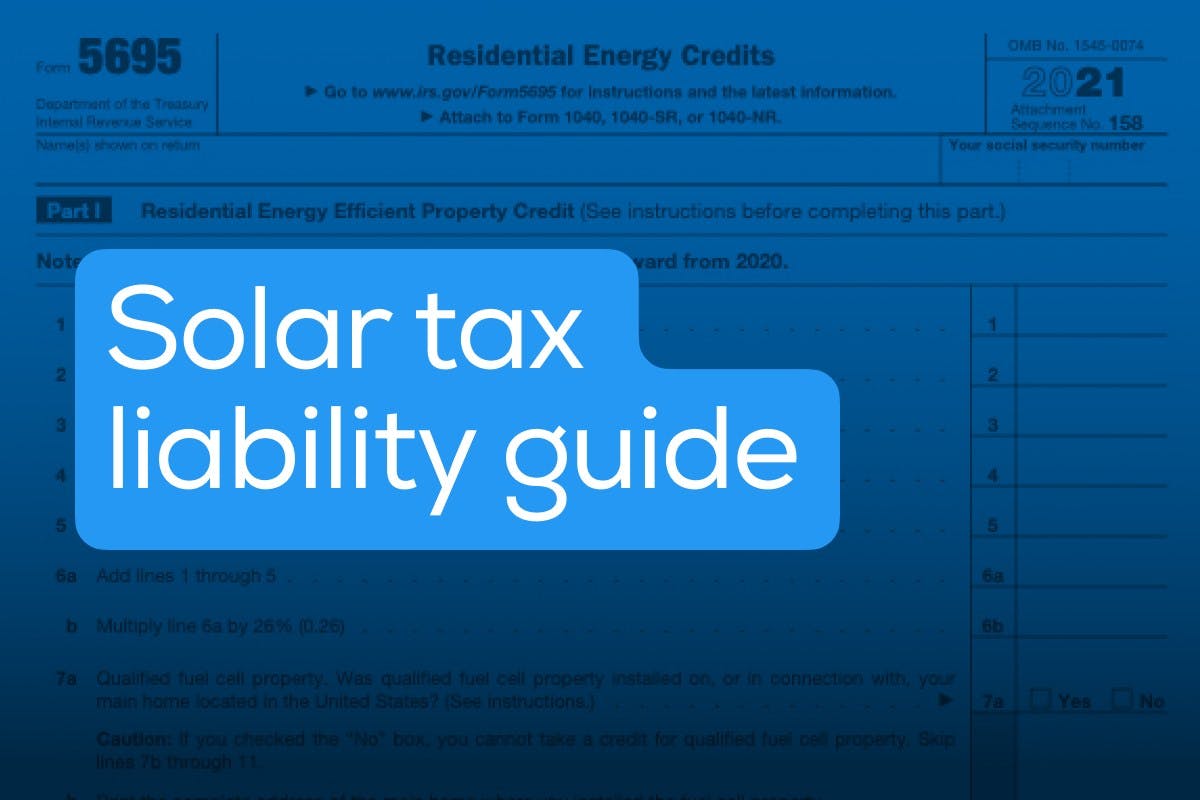Solar Tax Credit: Will I Get a Refund if My Liability Is Too Small?
Last edited

Author
Andrew Blok
Electrification and Solar Writer and Editor

Editor
Ryan Barnett
SVP, Policy & New Market Development

The federal solar tax credit, formally known as the Residential Clean Energy Credit, is one of the oldest and most valuable incentives for home solar panels.
When qualifying homeowners buy and install solar panels on a qualifying home, they can reduce their federal income taxes by 30% of the cost of installation, potentially thousands of dollars.
The RCEC is broadly available, but if you’re new to tax credits, you’ll need to know how to claim it, what your tax liability is, and what happens if it’s smaller than your tax credit.
See how much you can save by going solar with Palmetto
What Is The Solar Tax Credit?
The Residential Clean Energy Credit is a federal tax credit that was originally called the Investment Tax Credit, or ITC. It was enacted in 2006 to promote the adoption of solar energy in the United States. This tax credit can be as high as 30% of the total cost of your solar energy system.
The ITC was first introduced in the Energy Policy Act of 2005, and was meant to be a two-year incentive. However, thanks to its popularity and impact on the economy, Congress extended the ITC multiple times. According to the Solar Energy Industries Association (SEIA), “Since the ITC was enacted in 2006, the U.S. solar industry has grown by more than 10,000% — creating hundreds of thousands of jobs and investing billions of dollars in the U.S. economy in the process.”
Today, the solar tax credit is officially recognized by the IRS as the Residential Clean Energy Credit, after it was extended and rebranded in the Inflation Reduction Act of 2022. The 30% credit lasts until Dec. 31, 2032, and is set to phase down to 26% in 2033 and 22% in 2034, before expiring.
Tax credit for solar energy system owners vs. leases
The Residential Clean Energy Credit is a financial incentive available for solar energy system owners. If you purchase solar panels from a company (whether with cash or through financing), then you — and only you — can claim the tax credit. If you lease your solar panels, you will not be able to claim the tax credit on your system, though the savings may be passed on to you in a favorable lease or PPA contract agreement.
As a new solar power owner, you can make a claim only within the tax year when the system is installed and use begins, so it is essential to claim your tax credit during the next tax period to not miss out on valuable savings. With thousands of dollars of tax deductions, you will want to make sure you don't lose your solar tax credit!
What is the maximum value of the solar tax credit?
To encourage consumers to purchase systems that can support their power needs, there is no maximum amount you can claim for the solar tax credit. In addition, since solar power systems vary in capacity, prices are also different, which means the potential savings from the Residential Clean Energy Credit are also going to be different for each system. As such, it’s important to know everything about the solar tax credit before purchasing a solar power system.
What Is Tax Liability?
Government spending, which aims to ensure citizens have access to public services, is funded by taxes.
The amount you owe in taxes is referred to as your tax liability. You might owe taxes to tax authorities like the IRS, or to the state and local governments, and thus, have a tax liability.
There are different factors that contribute to your tax liability, such as earnings from salaries and wages, or gains from the sale of assets. Examples of tax liabilities include capital gains tax, income tax, and sales tax.
Income brackets and solar tax credit eligibility
Whether you make less than $10,000 or over $500,000 per year, you may be eligible for the same solar tax credit “refund” at equal system purchase price points. That said, the credit is only valuable if you have an outstanding income tax liability owed to the federal government.
While tax brackets and rates are subject to change, the information from the IRS below shows income tax rates for Americans in 2024 based on annual income. Using this information, you can get a rough estimate of your approximate liability if you know your annual taxable income amount.
| Tax Rate | Single Filer | Married Couple Filing Jointly | Head of Household |
|---|---|---|---|
| 10% | $11,600 or less | $23,200 or less | $16,550 or less |
| 12% | $11,601-47,150 | $23,201-94,300 | $16,551-63,100 |
| 22% | $47,151-100,525 | $94,301-201,050 | $63,101-100,500 |
| 24% | $100,526-191,950 | $201,051-383,900 | $100,501-191,150 |
| 32% | $191,951-243,725 | $383,901-487,450 | $191,151-243,700 |
| 35% | $243,726-609,350 | $487,451-731,200 | $243,701-609,350 |
| 37% | $609,351 or more | $731,201 or more | $609,351 or more |
Source: Internal Revenue Service
Individuals who do not have any form of income, or who have a very low income, may not have any tax liability. Therefore, if they qualify for a tax credit, they do not have any tax liability to receive the credit against, rendering the credit valueless.
On the other hand, those who live in low-income or underserved communities may also qualify for “bonus” solar tax credits between 10% and 20% in additional savings. The program, sponsored by the Office of Energy Justice and Equity, is open to applicants annually and may be limited to a specific number of projects and geographical regions.
What Is A Tax Credit?
A tax credit subtracts a certain dollar amount from the tax amount you owe. These tax credits help reduce your tax burden and reduce your tax liability.
In essence, tax liability represents your debt to the government, and in some cases, like with the solar tax credit, the government offers taxpayers ways to reduce the amount they owe. The government can offer tax credits to specific groups of people, locations, and industries in order to help them, or to advance a specific goal like the adoption of clean energy.
While they are somewhat similar, tax credits are different from tax deductions. A tax credit reduces the amount of tax owed, while a tax deduction reduces a taxpayer’s taxable income. Therefore, a $1 tax credit reduces the amount of taxes you owe by $1, while a $1 tax deduction will have a value that depends on your tax rate.
In short, you must owe at least as much money in taxes as the amount of your credit in order to receive the full amount of the solar tax credit in the same tax year.
Federal vs. state solar tax credits
To further reduce your total solar investment costs, it is possible to combine the federal solar tax credit with other local incentives, rebates, and programs. Today, state income tax credits for solar panels (for redemption on state income taxes rather than federal) are available in Massachusetts, South Carolina, Arizona, New Mexico, and several other states.
Critically, solar incentives are different everywhere and constantly changing. So whether you are considering energy credits in California, purchasing panels in Pennsylvania, or going green in Georgia, it is important to work with an expert who will help you identify and combine all of the potential solar incentives for which you qualify.
Difference between a refundable and non-refundable tax credit
Tax credits come in two primary categories: refundable and non-refundable tax credits. With refundable tax credits, you will receive a refund of the balance if your tax credit exceeds your tax liability. For instance, assume you are eligible for a $1,000 tax credit, but your tax liability is $800. Along with having your tax liability completely covered, you are also entitled to a refund of $200.
As the name suggests, with non-refundable tax credits, you cannot receive any refund beyond the amount the credit covers. As such, the maximum value you can receive is restricted to your total tax liability. This means you can lose out on the maximum potential benefits if your tax liability is too small for the Residential Clean Energy Credit. Suppose you are eligible for a $1,000 tax credit, but your tax liability is $600. While the tax credit will reduce your tax liability to $0, you will not get a refund for the additional $400 owed to you by the tax credit.
The Residential Clean Energy Credit is non-refundable, so you need to have enough tax liability available in order to receive the full value of the solar tax credit. However, there are options available if you don’t have enough tax liability in a single tax year.
Tax credits vs. rebates
Tax credits reduce the taxes you owe, federally or to a state. A credit may reduce your tax burden to zero in a given year. It may be able to be applied to multiple years, known as a carryforward or carryover or rollover, if the credit is more than the tax you owe.
A rebate is different from a tax credit in that a rebate is getting cash back, in some cases immediately, in some cases relatively shortly after, following a purchase or installation. You get the rebate back rather than waiting until filing taxes. In solar programs from a state or energy company, a rebate is often money back based on the panel capacity you install or for certain equipment, such as a solar battery.
See how much you can save by going solar with Palmetto
How The Residential Clean Energy Credit Works
If you want to maximize your savings, it’s important to understand how the Residential Clean Energy Credit works.
The tax credit was put in place to promote solar use, but not everyone who uses solar can qualify and be eligible to make a claim. To be eligible for the full 30% Residential Clean Energy Credit, you must meet the following criteria:
- Installation of the solar power system began between January 1, 2022, and December 31, 2032.
- The solar power system was installed in your primary or secondary residence within the United States.
- The solar power system is new or being put to use for the first time.
- You must own the solar power system, as leased equipment does not qualify (The company you lease the equipment from will receive the Residential Clean Energy Credit, and will typically use it to help lower your lease payments).
Any costs incurred during the installation of the solar power system can be included in the tax credit. These include components such as mounting equipment, batteries, and wires, as well as related costs such as labor, assembly, and inspection.
The after-purchase process
After purchasing your solar power system, you should file for the Residential Clean Energy Credit within the tax year, just like you file your federal taxes. For the solar tax credit, you are required to use Form 5695 for Residential Energy Credits.
Regardless of whether you use the federal income tax or the alternative income tax to calculate your tax liability, you can still claim the full value of the Residential Clean Energy Credit and receive the residential energy credit, as it can be used against both.
The Residential Clean Energy Credit is not the same as an up-front discount on your solar, since it is not applied to the cost of your solar power system at the time of purchase. Instead, you pay for the system (or finance it with a solar loan) and then it is your responsibility to claim the tax credit when you file your taxes.
Again, the federal solar tax credit is a non-refundable tax credit. However, this does not mean you will miss out on its full benefits if you have a small tax liability.
Additional energy-efficient upgrade credits
Beyond solar energy and other clean power systems, several passive technologies now qualify for the Residential Clean Energy Credit on a newly designated section of Form 5695. So in addition to the solar tax credit refund, upgrades like insulation, home energy audits, and modern doors or windows could qualify for further savings every calendar year the program is available.
Can solar tax credit refunds carry over?
To further incentivize solar power system installation, there is a tax credit carryover rule if your tax liability is too small for the Residential Clean Energy Credit. Your tax credit can be deducted from federal income taxes over several years, but this tax credit carryover can only happen during the period the IRS solar tax credit is in effect, so you need to have used the full credit by the time the credit expires on January 1, 2035.
What Forms Are Needed To Claim The Residential Clean Energy Credit?
Good news: Claiming the Residential Clean Energy Credit is easy! Once you've confirmed you are eligible, you will be required to fill out and attach IRS Form 5695 while filing your federal taxes. The Residential Clean Energy Credit forms ensure you get the full value of your tax credit.
Along with solar power, Tax Form 5695 helps taxpayers calculate tax credits for various other residential energy improvements such as solar energy storage, solar water heating, geothermal heat pumps, wind turbines, and fuel cells.
Completing Form 5695 may also involve working out rollover taxes if the value of your tax credit exceeds your tax liability. Once you are done, take the value that will be credited and enter it in the appropriate field of your Schedule 3 (Form 1040) - Additional Credits and Payments, and then enter your total credits on your Form 1040.
Each individual's tax situation is unique, so if you have questions about your eligibility for the Residential Clean Energy Credit, or how the solar tax credit factors into your overall tax return, it's best to seek the counsel of a professional tax consultant.
When Can I Claim The Residential Clean Energy Credit?
One of the requirements of claiming the Residential Clean Energy Credit is you do so within the same tax year your installation is completed. This period begins after your solar power system has been fully installed and is operational. If the value of the tax credit you are owed exceeds your solar tax liability during that tax year, you can still capitalize on its full value thanks to a unique provision of the credit.
Though it is a non-refundable tax credit, the Residential Clean Energy Credit employs a solar tax credit rollover system that allows you to collect your credit balance in subsequent years. Based on the present guidelines, you can rollover the balance for the duration of the solar tax credit until it expires at the end of 2034.
Do I Need a Tax Professional to Get a Solar Tax Credit Refund?
Although some tax-savvy homeowners may find the solar tax credit redemption process to be a breeze, in general, consulting a tax professional is recommended to help maximize your solar tax credit benefits. By working with a professional—preferably with local solar experience—you can ensure you are not overlooking any potential credit values for low-income opportunities, rollover, or other individual circumstances.
Can I Claim The Residential Clean Energy Credit If I Purchase My Solar Power System With A Solar Loan?
Yes, even if you purchase your solar power system with a solar loan, you can still claim the full value of the solar tax credit, and if you have enough tax liability, you can receive the full tax credit in the first year. With a solar loan, it’s possible to pay as little as $0 down when your solar power system is installed, while still receiving the valuable tax credit that’s based on the full value of your solar power system.*
Is It Possible To Claim The Residential Clean Energy Credit After A New Home Purchase?
Due to the benefits of solar power systems, they have now become a key consideration for many homebuyers. If you are considering the purchase of a new house with a solar power system, you are likely still eligible for the Residential Clean Energy Credit. (If you’re in this situation, check out the article we wrote to answer the question, “Is Solar a Good Investment for First-Time Homebuyers?”)
Even if the installation occurred over one year prior to the purchase or move-in date, the Residential Clean Energy Credit is still applicable. This is because the duration upon which it should be claimed only begins once the system is in use. Therefore, as long as you are the owner and first-time user, you can claim the Residential Clean Energy Credit regardless of the date the house was built or sold. You won’t be able to claim the credit if a previous owner claimed it. For instance, if you bought a house (primary or secondary) in 2022 but don’t move in until 2023, you can still make your Residential Clean Energy Credit claim during the 2023 tax year.
For more details and IRS fine print, you can go to the IRS page on the Residential Clean Energy Credit.
Can I Carry Forward The Residential Clean Energy Credit If My Tax Bill Is Smaller Than My Tax Credit?
To put it simply, yes, you can carry forward the solar tax credit if your tax bill is smaller than your tax credit! A carry forward is a provision in the tax law that allows taxpayers to apply some of their unused credits, deductions, or losses to a future tax year.
Solar tax credit carryover rules explained
You may find your tax liability is too small for the Residential Clean Energy Credit in a single year due to a low tax liability, or because you are eligible for a high solar Residential Clean Energy Credit.
- For instance, with a 30% tax credit, if the cost of installing your solar power system is $10,000, you may qualify for a solar tax credit of up to $3,000.
- If your total tax liability for that tax year is $1,500, then the maximum amount that can be received in that year is $1,500, and you will need to use a tax credit carryforward to receive the remaining $1,500.
How many years can the solar tax credit carry over?
In the government’s quest to ensure consumers enjoy the full value of the Residential Clean Energy Credit, there is a provision that allows you to claim the balance in the following years. However, if there is a significant difference between your tax credit and tax liability, there's a chance you may miss out on some benefits of the tax credit. Current guidelines stipulate that solar tax credits can only be claimed for as long as the Residential Clean Energy Credit is active, through December 31, 2034.
What Options Are Available If I Have No Tax Liability?
People on fixed incomes, or those with little to no tax liabilities like retirees, may be wondering, "How does the solar tax credit work if I don't owe taxes?"
Since tax credits work by reducing your federal taxes, certain groups of individuals may miss out on those benefits. While you may not capitalize on the tax credit if you have no tax liability, investing in solar power can still be a worthwhile choice that can provide overall savings on your energy costs.
Some of the benefits of going solar include:
- Reduce or even eliminate your utility costs
- Earn net metering credits in some areas to offset additional utility costs
- Control where your electricity comes from, and how it’s used
- Contribute to a greener and more sustainable world
Another option for those with no tax liability is a solar lease or power purchase agreement (PPA). With these types of solar financing agreements, the company that owns the solar power system receives the Residential Clean Energy Credit using their own tax liability, and then it can pass along some or all of those savings to the homeowner.
How Much Can I Save With The Residential Clean Energy Credit?
Undoubtedly, the Residential Clean Energy Credit is a great incentive for investing in solar power. You can earn savings of up to 30% the cost of your solar panels on your federal taxes while earning electric bill savings for years to come.
At Palmetto, we are committed to leading the world towards a clean energy future. Are you interested in capitalizing on the benefits of solar power and the solar tax credit? Begin your journey by using our free cost-savings calculator to find out how much you can save by installing a solar power system, which includes the amount you’d save thanks to the Residential Clean Energy Credit. We are here to provide you with the necessary information and support you need to become a solar-powered home.
Solar Tax Credit FAQs
What is the income limit for the federal tax credit?
There is no income limit to use the federal solar tax credit.
Is the federal solar tax credit a refund?
No, the federal solar tax credit is not a refund. You apply it to your federal tax return each year, using Tax Form 5695. Your taxes owed are decreased by up to 30% of your expenses in going solar.
What disqualifies you from the federal solar tax credit?
You may not qualify for the solar tax credit if your tax liability is zero. If your overall liability is less than the credit, you can rollover or carry forward the remaining credit to the next tax year. You also do not qualify if you lease your solar system.
Is solar worth it?
There are multiple factors we look at and help you with to determine if solar might be a good solution for your needs, including roof space, home energy usage, credit health, and eligibility for incentives. At Palmetto, we start by calculating a savings estimate based on your home, location, and current electricity costs. We can then outline options based on your goals and the specifics of your home. All of this happens before you buy, allowing you to decide if solar is right for you based on a clear understanding of the potential costs and savings.
See what solar can do for you:
*See Palmetto Truth in Lending Act Disclosures for pricing and payment details.
General Disclaimer: This content is for educational purposes only. Palmetto does not provide tax, legal, or accounting advice. Please consult your own tax, legal, and accounting advisors.


